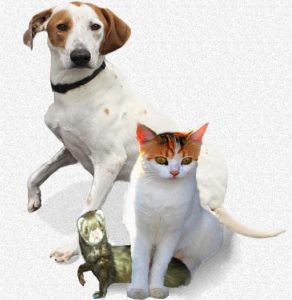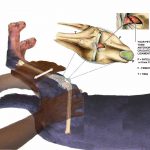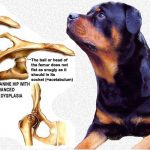Why Is My Dog Or Cat Limping?
Ron Hines DVM PhD
 Galliprant A Newer Option For Chronic Arthritis Pain In Dogs
Galliprant A Newer Option For Chronic Arthritis Pain In Dogs
 What Can I Do When My Cat Is In Pain?
What Can I Do When My Cat Is In Pain?
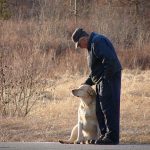 Arthritis Pain In Your Older Dog
Arthritis Pain In Your Older Dog
Do not give aspirin, ibuprofen or Tylenol to your dog or cat. Over-the-counter pain remedies are hard on a dog stomach and intestines and can be fatal to cats (so can Tylenol®). If the problem is serious enough for you to consider a pain reliever for your pet, it is serious enough to seek your local veterinarian’s advice.
That said, some of the most frequent visitors to veterinary hospitals are limping dogs, cats and other pets. Sometimes your veterinarian’s initial physical examination identifies a simple cause and solution – but just as often, the cause is not that easily determined and the required tests and possible solutions are more complex.
The majority of lamenesses we see in younger pets resolve themselves within a week or so. These transient problems often get better without your veterinarian or you ever determining the exact cause of the pain or the nature of their injury. These “benign” lamenesses are the ones that are due to strains, bruises and minor injuries that all of us endure. Other times, the lameness is due to a thorn, a splinter or perhaps a broken toenail. When a careful examination discovers them and the problem is attended to, they resolve with no lasting damage. Dogs and cats are inclined to bite (or scratch) when you hurt them. Be exceedingly careful when probing or poking a limping animal. Those examinations are best left to a professional.
More severe lamenesses – the ones that cause severe pain or do not resolve themselves promptly or are accompanied by other health changes – require a trip to your veterinarian right now. You also need to schedule an appointment with your veterinarian when even minor lamenesses or limping come and go more than once.
I, like most veterinarians, perform a similar initial examination on all limping pets that are brought in for examination. Your pet’s entire body needs to be examined because sometimes the most obvious problem is not the only or most serious health issue. This article discusses some of the more common causes of lameness that veterinarians see. There are many more I do not mention.
How Does My Veterinarian Determining Which Specific Area Is Causing My Pet Pain?
Most – but not all – leg pain is related to one or more painful joint. Determining which joint might be causing your pet’s lameness can be quite challenging. Sometimes the affected joint can be identified by noting swelling, heat or pain over that joint. But some pets are much more stoic than others about telling you where they hurt. In those cases, gently over-flexing the affected joint often temporarily increases their limp. In some cases, it is the owner who picks up first on subtle signs of pain this causes and informs the examining veterinarian. It can be quite difficult to identify which leg is causing a pet to slightly limp. Usually, the pet’s head will rise when the sore limb bears weight and go slightly down when it doesn’t. The pet might also shift its weight slightly to the side of its body and legs that is not producing the pain.
Dogs and cats with rear leg pain often carry those legs farther forward than normal and their hip on the affected side a bit higher. Pets with front leg pain are often reluctant to move. When pets favors a leg, over time the toenails on that limb tend to be longer than on the non-painful legs. That may be enough to identify the limb that is causing its abnormal walk.
When physical observations are not enough, when the problem might be serious, or just to gain more information, x-ray views of your pet’s suspected joints as well as the corresponding joint on the opposite leg are indicated. Some painful joints appear normal on x-rays. In those cases, the bone is probably not affected, or the injury is too recent to have produced changes in the bone. Those are generally injuries to supporting ligaments. The best way to decide if a joint is abnormal in an x-ray is to compare it to the opposite leg.
How Should My Pet’s Paws Be Examined?
Your pet’s paws need to be examined carefully for thorns and stickers. Grass sand spurs  , caught between the foot pads, are a common cause of limping in the southern United States where I live. This is particularly true in pets that have heavy fur between their toes. Once the pesky thorn is removed, these wounds rarely become infected. Nevertheless, depending on the condition of the tissue surrounding a thorn puncture or laceration, your veterinarian might decide that it warrants an antibiotic. Topical antibiotics applied to paw punctures and lacerations are of no value. The pet simply licks it off. If you want to decontaminate a puncture, use dilute hydrogen peroxide. Again, remember that pets in pain will often nip or bite.
, caught between the foot pads, are a common cause of limping in the southern United States where I live. This is particularly true in pets that have heavy fur between their toes. Once the pesky thorn is removed, these wounds rarely become infected. Nevertheless, depending on the condition of the tissue surrounding a thorn puncture or laceration, your veterinarian might decide that it warrants an antibiotic. Topical antibiotics applied to paw punctures and lacerations are of no value. The pet simply licks it off. If you want to decontaminate a puncture, use dilute hydrogen peroxide. Again, remember that pets in pain will often nip or bite.
Paw Lacerations
Paw Lacerations (cuts) are most common in large active dogs. These are often due to treading on sharp glass or metal fragments. But they also occur when pets are bumped by cars and skid on the pavement. Paw lacerations are much less common in cats. When they occur, they are usually infected, very swollen and the result of cat fights. Those cats often run a fever. Hot summer road asphalt can also burn the foot pads of dogs. When they occur in ferrets it is usually because they have caught their foot in their caging.
Even moderately large paw lacerations usually heal quite well without suturing. I usually recommend that cut foot pads be soaked four times a day in warm hydrogen peroxide solution or tame iodine solution (e.g. Betadine™). My experience has been that paw bandages and gauze tend to trap unwanted moisture, bacteria and debris in the wound and actually slow healing. When a paw is bandaged, the bandage needs to come off as soon as bleeding has stopped. Cut paws need to stay dry and clean until they heal. Injured pets usually lick hurt paws. That licking rarely if ever retards healing or contributes to infection. Sniff bandaged and unbandaged hurt paws frequently for any telltale odor of infection. When in doubt about infection, take your pet’s temperature as well if it will permit you to.
Deep puncture wounds
Deep puncture wounds and seriously infected paws always need systemic antibiotics given orally or by injection. I mentioned that anything you apply directly to the paw will most likely be licked off by your pet and that bandages trap infection – so it is much better to treat these injuries from the “inside” rather than topically.
Overgrown or overly short toenails
Overgrown or overly short toenails frequently cause limping. Overly long nails are particularly a problem in older, less active pets. When these nails break off, they can expose the sensitive quick. Broken nails quickly become infected and are very painful due to the exposed toenail nerve combined with the moisture of licking and contamination. These nails need to be cut off straight and cauterized in order for them to heal properly. This is a painful procedure. It should be done, professionally, under moderate anesthesia. I do not do local anesthetic blocks on feet as your dentist might for a tooth extraction because there is not enough soft tissue to reliably disperse the anesthetic without causing pain. Breaks in overly long toenails are often incomplete with the most distant portion bent to one side or hanging incompletely separated. These partially fractured toenails will not heal and every time they bump into objects they begin to bleed again. The pet may go sound (not limp) for a while, but the pain will reoccur. Your pet’s comfort requires that the distal (end) potion be removed.
Very active dogs and dogs housed on concrete often wear their toenails down to the sensitive quick. With time, the quick on these nails will recede and should cause them no pain or limp, but I suggest you modify your dog’s environment and schedule to avoid abnormally short toenails. Once a toenail is worn so short that it no longer bear weight, it usually becomes pain free – but I still feel sorry for these dogs in any case.
When your pet’s nails are allowed to overgrow, they also twist the joints of the foot and modify weight forces in ways that lead to arthritis and pain. Severely overgrown nails also need to be clipped off short and cauterized by your veterinarian under a mild anesthetic. Although there is no danger of a pet with a normal blood clotting mechanism bleeding to death from short-cut toenails, it is a procedure that should only be attempted by a veterinarian or an experienced groomer. Antibiotics are rarely if ever required.
Dogs with canine atopy (skin allergies) or anxiety issues often lick their paws incessantly causing infections, abscesses and cysts to develop between their toes. This is very painful and can cause your pet to limp. Treating the paws with an astringents and topical steroids will give your dog temporary relief; but the pet’s general allergic condition needs to be dealt with if the problem is not likely to reoccur frequently.
Your Pet’s Elbows:
Unstable elbow joints are subject to pain and eventually arthritis. If your dog or cat shows signs of a front leg limp that does not resolve promptly or returns intermittently, it needs to be taken to your veterinarian to have its forelegs evaluated. Many pet owners suspect that their cat or dog has a shoulder problem when, in fact, the problem is lower down in their elbow. You can read about arthritis problems in dogs and what might be done to help them. (read here)
Pain in our pets that is associated with their elbows tends to be serious and progressive. The most common causes of elbow pain in young dogs is elbow dysplasia, where fragments of bone (the medial coronoid process) are present in the elbow joint and an un-united anconeal process exists (two portion of one of the bones that form the elbow fail to fuse). These are serious conditions that will become worse if they are left untreated. (read here) Some owners and veterinarians opt to treat these pets medically with non-steroidal anti-inflammatory medicines for a number of years. Others make immediate attempts to repair the joints surgically. Surgery offers hope of slowing or stopping the slow, progressive destruction of the joint that invariably occurs. Any pet with this problem needs to maintain a trim body weight because dogs and cats carry about 70% of their weight on their front legs. Some have found that diets rich in omega-3 fatty acids (cold water fish) appeared to slow the progress of the elbow disease. (read here) These are not conditions that pet owners can diagnose or treat by themselves. Specialized x-rays and knowledge are required to detect the problem and sophisticated surgical devices and procedures (arthroscopy) are required to correct them.
Another common problem that occurs in the elbows of dogs is osteochonritis dissecans (aka osteochondrosis) in which a flap of cartilage breaks loose within the joint causing pain when it is trapped between opposing joint surfaces. Too rapid a growth rate, genetic factors and trauma to the joint can all play a part in this disease. I would include neutering pets at too young an age as a potential cause as well. (read here) Sex hormones are a necessary ingredient for proper skeletal formation. These flaps and floaters (joint mice) need to be removed surgically.
Your Dog And Cat’s Shoulders:
The shoulder joint of some dogs is also subject to osteochonritis dissecans. The heavy shoulder muscles of your dog make detection of inflammation and swelling through palpation and visual examination difficult when the shoulder is involved. However, rapidly extending and contracting the shoulder joint of a pet with shoulder issues often causes detectable discomfort and/or exaggerates the limp afterwards. Not all cases are visible on standard x-ray positioning. So, it is sometimes necessary to examine these joints with fiber-optical apparatus to confirm or dismiss this problem as the cause of your pet’s lameness (apparatus similar to these arthroscopes). A few cases do heal on their own without surgery when your dog’s exercise is restricted, and it is given anti-inflammatory medications. But since your veterinarian won’t know which cases these will be, and because irreversible arthritis of the shoulder often develops when surgery is withheld; it is usually best to surgically remove these fragment(s) of cartilage early in the disease process.
Occasionally, inflammation of the tendons (tendinitis) that anchor major muscles of the shoulder or an outright torn ligament occur after a shoulder injury. This problem usually improves when a long-acting corticosteroid (such as Depo-Medrol®) is injected into the affected area and the pet is given an extended period of rest.
Please remember that corticosteroids, to reduce joint inflammation and NSAIDs to reduce pain and inflammation will probably make your dog, cat or other pet run and roughhouse just like it used to. But neither of these drugs is a substitute for the extended rest that your pet needs for its joint to truly heal. Ligaments have minimal blood supply, so they heal very slowly. Corticosteroids and NSAIDs both relieve inflammation and pain. They do nothing to promote healing. In fact, corticosteroids actually slow healing since inflammation is the first step in the healing process. Allowing your pet to resume its former activities before complete healing has occurred is a tempting invitation to disaster.
Panosteitis (“growing pains”)
Panosteitis is an inflammatory disease of the bones of young dogs, which often causes lameness that shifts from one leg to another. It is also called enostosis, eosinophilic panosteitis or juvenile osteomyelitis. For unknown reasons, panosteitis is particularly common in German Shepherd dogs. Eighty percent of the dogs that develop this problem are males less than two years of age. Firmly grasping the bones of the legs will often cause these dogs to yelp. The cause of panosteitis is unknown. Early in the lameness phase of the disease, x-rays tend to be normal. Panosteitis in dogs is a transient disease that cures itself with “tincture of time” (=patience). Associated pain needs to be managed by your veterinarian. I have never encountered a case in cats.
Your Pet’s Knee or Stifle:
Luxating Patellas (“knee caps”) or “Trick Knees” are quite common in toy dog breeds. They also occasionally occur in cats – particularly purebred and inbred cattery cats. When the problem occurs in ferrets, it is usually due to having its leg stepped on or wrenched in some other manner that ruptures one or more of the associated ligaments. That could conceivably happen in dogs and cats as well.
In almost all non-traumatic cases, your pet’s kneecap pops out of its track toward the inside (medial side) of the knee joint. Patella luxation in dogs and cats is most often an inherited problem caused by poor alignment of the thighbone (femur) with the shinbone (tibia) as well as an abnormally shallow groove that the patella rides within. You can see that groove and the surrounding anatomy here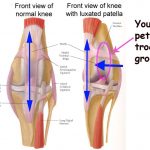 (I circled the groove in pink). You can read about this problem in detail here. When it is an inherited problem (and it usually is), your pet may favor one leg over another, but both knees almost always share the problem to some extent. Occasionally, it will occur as a single-side problem after a severe accident that wrenched the pet’s knee. Luxating patella causes intermittent, painless lameness, which locks the knee during the time the patella is out of its tract or groove. Surgery to correct this problem is straight-forward and usually very successful.
(I circled the groove in pink). You can read about this problem in detail here. When it is an inherited problem (and it usually is), your pet may favor one leg over another, but both knees almost always share the problem to some extent. Occasionally, it will occur as a single-side problem after a severe accident that wrenched the pet’s knee. Luxating patella causes intermittent, painless lameness, which locks the knee during the time the patella is out of its tract or groove. Surgery to correct this problem is straight-forward and usually very successful.
Anterior (cranial) cruciate ligament injury
Anterior cruciate ligament tears are one of the most common knee injuries of dogs. They are also among the most difficult injuries to successfully treat. Cats that are overweight or have multiple health problems occasionally develop the problem as well. Cruciate ligament tears also occurs sporadically in ferrets. You can read about this problem and its treatment in dogs here and and a review of its occurrence and treatment in cats here. Despite what you read in that article about non-steroidal products (NSAIDs) being used to treat this problem in cats – be exceptionally careful and cautious if that is attempted. Cats do not tolerate NSAIDs well.
When a cruciate tear occurs in your pet, it will suddenly refuse or be reluctant to bear weight on the affected leg. Surgery to correct this problem is considerably less successful than one might hope for. In dogs weighing less than 40 pounds, lameness often resolves itself or becomes manageable without surgical treatment. A period of 5-10 wks with initial cage rest, later exercise restriction, physical therapy and medications during recovery to control pain is required. Maintenance or return to a healthy, lean body weight is important. There are a large number of surgical techniques in use in an attempt to stabilize your pet’s knee. No valid studies comparing the success of the various surgical techniques against each other or to non-surgical therapy exist. Later arthritic knee changes are not prevented by any of the current surgical techniques. Proponents of surgery say that these arthritic changes would be worse had the surgery not been performed. That is really impossible to know. At a minimum, a long period of rest, weight control in overweight pets and physical therapy are needed to get pets through this problem. Leg braces are quite helpful if your pet will tolerate them. It is also critical that the brace be designed so that it is worn comfortably and is neither too tight nor too loose (unless a strap goes over the back and around the unaffected leg, it will probably not stay on). Much like back problems in humans – there is no agreement among physicians or veterinarians as to what the best treatment really is.
Torn Knee Meniscus
Knee injuries to your pet can result in tears of the elastic cartilages that cushion its knee joints called the meniscus. These structures act as a shock absorbers. Sometimes damage to them occur in conjunction with cruciate ligament damage. We associate meniscal tears with large dogs; but they can occur in any size pet subsequent to trauma. Sometimes the knees of dogs with this problem “click” as they walk. Meniscal tears rarely heal on their own because cartilage, like tendon, is a tissue with a poor blood supply. In larger pets, the meniscus can be rasped smoothed with the aid of arthroscopic surgery and the tags of torn tissue that are unlikely to reunite removed. Surgically opening the knees of small pets in older traditional manners requires that many important structures be cut and then replaced as best the surgeon can. I generally do not recommend that that be done in smaller dogs or cats. Arthroscopic minimally invasive surgery is the better option.
Arthritis
Nearly all pets, like nearly all people, develop some degree of arthritis as they age. It is common to see stiffness and morning lameness associated with arthritis in dogs over 8 years old, cats over 12 years old and ferrets over 7 years of age. Pets that are unusually large for their breed (“an eye-catching presence”) and breeds that were intentionally bred to have abnormal conformation do not stand vertically on their legs (bulldogs, bassets, etc.) The scientific term for them is achondroplastic/aka osteochondrodysplastic. These problematic animals are also more at risk of developing joint issues earlier in life. Signs of arthritis are usually visible on x-rays long before you notice changes in your pet. The severity of the damage your veterinarian sees on x-rays may not accurately reflect the amount of pain your pet is actually experiencing. Some pets I see with horrible looking x-rays do not seem to be in pain at all and some with only minimal bone changes are in obvious discomfort. You will find some non-drug methods of dealing with arthritis in older pets here and here.
If your pet suffered an injury to a leg joint earlier in life, arthritis might develop in that limb years later. For example, the front left legs of racing greyhounds (the “rail side”) are known to develop considerably more arthritis than their right one because the left front leg taking the most pounding as the dog runs counter-clockwise on the track.
Here Are A Few Things You Can Do To Delay The Onset And Progress Of Arthritis:
1) Do not allow your pet’s toenails to overgrow.
2) Do not overfeed growing pets – their body weight can increase faster than the strength of their bones. This can cause the bones to bow, placing the weight improperly on the pet’s joints. It also encourages laxity in the joints that leads to early arthritis. This is particularly true in large breeds of dogs.
3) Do not allow your pet to become overweight. A moderate amount of daily exercise, like taking walks with your pets will also delay arthritis.
4) Hot tubs, whirlpools and swimming are great for pets that already suffer from arthritis and all the suggestions that apply to people with arthritis, apply to pets as well. You can find more suggestions on physical therapy for pets here.
5) Early-age (pediatric) neutering of dogs and cats deprives them of the sex hormones that are essential for the development of strong bones and ligaments during their adolescent period when those structures are maturing. It also promotes obesity which puts extra weight on their joints. I do not advocate spaying or neutering dogs and cats until they have fully matured. You can read more about that here.
Hip Dysplasia
It is common for dogs with hip dysplasia to limp or rise with stiffness. Hip dysplasia also occurs in cats – particularly big-boned cats like Maine Coon, Persians and Chartreux. Both hips are almost always affected, but the limp is usually worse on one side. It may shift from leg to leg. The age at which hip dysplasia affects a pet depends on the severity of the inherited disease. You can read more about the problem here.
Bone Tumors
Older pets, particularly larger breeds, are susceptible to tumors of the bone called osteosarcomas. The first sign of these tumors is often limping, and it is not uncommon for pets to visit the vets with a limping problem several times before the true cause is discovered. Osteosarcomas commonly occur near a leg joint. On radiographs (x-rays), these tumors often have a characteristic “star burst” appearance. When they have not spread to the lungs, and they are present on a rear leg, they can be treated successfully by amputation of the limb. But one might question the humaneness of amputating the front leg of an active animal.
Myositis
Most myositis or chronic muscle inflammations are thought to be autoimmune disease in which your pet’s immune system begins to attack its own muscle and connective tissues in error. The most common form affects the muscles of the pet’s jaw, not its leg muscles (read here), but a second form that affects the legs also occasionally occurs (read here). Diagnosis of myositis is made by removing a tiny sample of your pet’s affected muscle for microscopic evaluation by a pathologist (a biopsy). This disease often goes through waves of activity or flare-ups during which the pet is in pain and reluctant to walk. It can be controlled with medications that suppress inflammation. Its treatment and progression in dogs and cats is the same as it is in humans.
Diseases Carried By Parasites (Parasite-Borne)
Diseases of pets caused by organisms that are transferred through blood-sucking parasites (usually ticks) seem to be becoming more common. The first sign of these diseases is sometimes lamenesses. That is because a number of these organisms trigger a process of joint inflammation known as polyarthritis (polyarthritis has other possible causes as well). These tick and parasite-borne diseases include Lyme disease, Ehrlichia, Babesia, Bartonella and Rocky Mountain Spotted Fever. Your veterinarian has accurate blood screening tests available to detect them. The organisms are as tough and as stubborn as the ticks that carry them, and they are a real challenge to permanently cure. Currently, doxycycline and minocycline are the preferred antibiotics. Read about tests for these diseases here.
Autoimmune Problems – Allergies to Self
Dogs and cats with autoimmune diseases sometimes develop lameness. One form of autoimmune disease in dogs and cats, similar to pemphigus, can cause inflammation of the paws. It is common for these pets to also lose pigmentation and develop crustiness around their mouth, eyes and anus. There are medications (corticosteroids) to control this condition and bring it into remission.
Bites And Stings
Infected tick bites, bee stings, spider and snake bites on the paw and lower foot can be the cause of sudden lameness. They may not be immediately apparent when you examine your pet’s leg. As with thorns and cuts, carefully clipping the fur from the leg of long-haired pets is sometimes the best way to locate and treat them. These bites and stings are often accompanied by considerable swelling. The pain and swelling associated with stings generally subsides in an hour or two. When it is accompanied by facial swelling, paleness, generalized weakness or rapid respiration, the pet is experiencing an anaphylactic reaction and needs to be rushed to your veterinary hospital.
Back Injuries
Some pets with back problems appear to their owners to have leg problems. X-rays are required to rule back problems in or out. These types of injuries and degenerative conditions are most common in dachshunds and other breeds with bizarre conformation. Occasionally, knee and back problems will occur in the same dog.
Improperly Performed Cat Declaw Surgery
When a portion of a nail root is inadvertently left in a cat that was surgically declawed, the cat’s paw will eventually become quite painful, and it will limp. All limping, declawed cats need to have their toe incisions checked carefully for nail root remnants. If present, they need to be surgically removed. Similar chronic lameness problems occur when too much is removed. For that, I know of no cure.
Feline Calicivirus
Feline calicivirus infection is usually associated with upper respiratory tract and oral symptoms. However, certain strains of the virus can also cause fever and limping. This problem, called Limping Syndrome, has also occurred subsequent to vaccinating cats against calicivirus. Read about that here.
Heart Disease In Cats
Cats are subject to a form of heart disease, cardiomyopathy, which often produces blood clots that leave the cat’s heart and lodge in major arteries where they obstruct blood flow. A common place for these clots to lodge and block blood flow is where the major blood artery (the posterior aorta) divides to supply blood to both back legs. Cats in this situation often limp or drag one or both rear legs. Read more about this disease in cats here. Dogs are also susceptible to cardiomyopathy. However, obstructing blood clots are not a common feature of this disease in dogs.
Rear Leg Weakness In Ferrets
Ferrets are amazing in that so many health issues they experience result in rear leg weakness and an unsteady gait. The problem is rarely in the legs themselves. Anemia, adrenal tumors, lymphoma, insulinoma and spinal injury have all been known to cause a wobbly gait. Articles on most of those conditions are on my website. Search for them here.
You are on the Vetspace animal health website
Visiting the products that you see displayed on this website help pay the cost of keeping these articles on the Internet.

